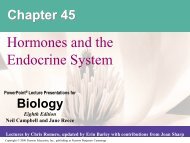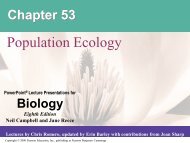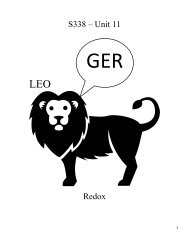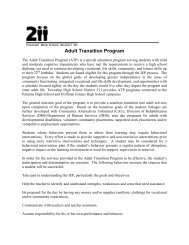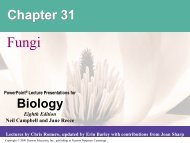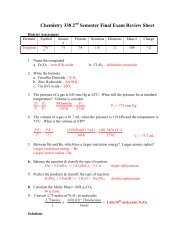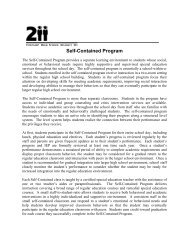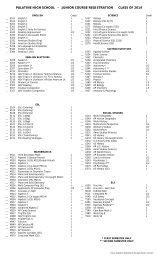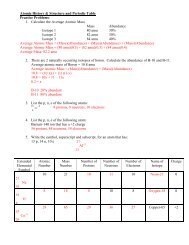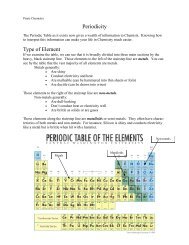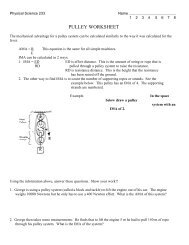Ch 33 PPT
Ch 33 PPT
Ch 33 PPT
Create successful ePaper yourself
Turn your PDF publications into a flip-book with our unique Google optimized e-Paper software.
<strong>Ch</strong>apter <strong>33</strong><br />
Invertebrates<br />
PowerPoint ® Lecture Presentations for<br />
Biology<br />
Eighth Edition<br />
Neil Campbell and Jane Reece<br />
Lectures by <strong>Ch</strong>ris Romero, updated by Erin Barley with contributions from Joan Sharp<br />
Copyright © 2008 Pearson Education, Inc., publishing as Pearson Benjamin Cummings
Fig. <strong>33</strong>-1
Overview: Life Without a Backbone<br />
• Invertebrates are animals that lack a<br />
backbone<br />
• They account for 95% of known animal species<br />
Copyright © 2008 Pearson Education, Inc., publishing as Pearson Benjamin Cummings
Fig. <strong>33</strong>-2<br />
Calcarea<br />
and Silicea<br />
ANCESTRAL<br />
PROTIST<br />
Cnidaria<br />
Common<br />
ancestor of<br />
all animals<br />
Eumetazoa<br />
Bilateria<br />
Lophotrochozoa<br />
Ecdysozoa<br />
Deuterostomia
Fig. <strong>33</strong>-3-1<br />
Calcarea and Silicea (5,500 species)<br />
Placozoa (1 species)<br />
0.5 mm<br />
A sponge<br />
Cnidaria (10,000 species)<br />
A placozoan (LM)<br />
Ctenophora (100 species)<br />
A jelly<br />
Acoela (400 species)<br />
1.5 mm<br />
Acoel flatworms (LM)<br />
A ctenophore, or comb jelly<br />
LOPHOTROCHOZOANS<br />
Platyhelminthes (20,000 species)<br />
Rotifera (1,800 species)<br />
A marine flatworm<br />
Ectoprocta (4,500 species)<br />
Brachiopoda (<strong>33</strong>5 species)<br />
A rotifer (LM)<br />
Ectoprocts<br />
A brachiopod
Fig. <strong>33</strong>-3-2<br />
Acanthocephala (1,100 species)<br />
Cycliophora (1 species)<br />
An acanthocephalan (LM)<br />
100 µm<br />
A cycliophoran (colorized SEM)<br />
Nemertea (900 species)<br />
Mollusca (93,000 species)<br />
A ribbon worm<br />
Annelida (16,500 species)<br />
An octopus<br />
A marine annelid<br />
ECDYSOZOA<br />
Loricifera (10 species)<br />
50 µm<br />
Priapula (16 species)<br />
A loriciferan (LM)<br />
A priapulan
Fig. <strong>33</strong>-3-3<br />
Tardigrada (800 species)<br />
Onychophora (110 species)<br />
100 µm<br />
Tardigrades (colorized SEM)<br />
An onychophoran<br />
Nematoda (25,000 species)<br />
Arthropoda (1,000,000 species)<br />
A roundworm<br />
A scorpion<br />
(an arachnid)<br />
DEUTEROSTOMIA<br />
Hemichordata (85 species)<br />
An acorn worm<br />
Echinodermata (7,000 species)<br />
<strong>Ch</strong>ordata (52,000 species)<br />
A sea urchin<br />
A tunicate
Fig. <strong>33</strong>-3a<br />
A sponge
Fig. <strong>33</strong>-3b<br />
A jelly
Fig. <strong>33</strong>-3c<br />
0.5 mm<br />
A placozoan (LM)
Fig. <strong>33</strong>-3d<br />
A ctenophore, or comb jelly
Fig. <strong>33</strong>-3e<br />
1.5 mm<br />
Acoel flatworms (LM)
Fig. <strong>33</strong>-3f<br />
A marine flatworm
Fig. <strong>33</strong>-3g<br />
A rotifer (LM)
Fig. <strong>33</strong>-3h<br />
Ectoprocts
Fig. <strong>33</strong>-3i<br />
A brachiopod
Fig. <strong>33</strong>-3j<br />
An acanthocephalan (LM)
Fig. <strong>33</strong>-3k<br />
100 µm<br />
A cycliophoran (colorized SEM)
Fig. <strong>33</strong>-3l<br />
A ribbon worm
Fig. <strong>33</strong>-3m<br />
An octopus
Fig. <strong>33</strong>-3n<br />
A marine annelid
Fig. <strong>33</strong>-3o<br />
50 µm<br />
A loriciferan (LM)
Fig. <strong>33</strong>-3p<br />
A priapulan
Fig. <strong>33</strong>-3q<br />
100 µm<br />
Tardigrades (colorized SEM)
Fig. <strong>33</strong>-3r<br />
An onychophoran
Fig. <strong>33</strong>-3s<br />
A roundworm
Fig. <strong>33</strong>-3t<br />
A scorpion<br />
(an arachnid)
Fig. <strong>33</strong>-3u<br />
An acorn worm
Fig. <strong>33</strong>-3v<br />
A sea urchin
Fig. <strong>33</strong>-3w<br />
A tunicate
Concept <strong>33</strong>.1: Sponges are basal animals that lack<br />
true tissues<br />
• Sponges are sedentary animals from the phyla<br />
Calcarea and Silicea<br />
• They live in both fresh and marine waters<br />
• Sponges lack true tissues and organs<br />
Copyright © 2008 Pearson Education, Inc., publishing as Pearson Benjamin Cummings
Fig. <strong>33</strong>-UN1<br />
Calcarea and Silicea<br />
Cnidaria<br />
Lophotrochozoa<br />
Ecdysozoa<br />
Deuterostomia
• Sponges are suspension feeders, capturing<br />
food particles suspended in the water that pass<br />
through their body<br />
• <strong>Ch</strong>oanocytes, flagellated collar cells, generate<br />
a water current through the sponge and ingest<br />
suspended food<br />
• Water is drawn through pores into a cavity<br />
called the spongocoel, and out through an<br />
opening called the osculum<br />
Copyright © 2008 Pearson Education, Inc., publishing as Pearson Benjamin Cummings
Fig. <strong>33</strong>-4<br />
<strong>Ch</strong>oanocyte<br />
Osculum<br />
Food particles<br />
in mucus<br />
Flagellum<br />
<strong>Ch</strong>oanocyte<br />
Collar<br />
Azure vase sponge (Callyspongia<br />
plicifera)<br />
Spongocoel<br />
Phagocytosis of<br />
food particles<br />
Amoebocyte<br />
Pore<br />
Spicules<br />
Epidermis<br />
Mesohyl<br />
Water<br />
flow<br />
Amoebocytes
• Sponges consist of a noncellular mesohyl<br />
layer between two cell layers<br />
• Amoebocytes are found in the mesohyl and<br />
play roles in digestion and structure<br />
• Most sponges are hermaphrodites: Each<br />
individual functions as both male and female<br />
Copyright © 2008 Pearson Education, Inc., publishing as Pearson Benjamin Cummings
Concept <strong>33</strong>.2: Cnidarians are an ancient phylum of<br />
eumetazoans<br />
• All animals except sponges and a few other<br />
groups belong to the clade Eumetazoa,<br />
animals with true tissues<br />
• Phylum Cnidaria is one of the oldest groups in<br />
this clade<br />
Copyright © 2008 Pearson Education, Inc., publishing as Pearson Benjamin Cummings
Fig. <strong>33</strong>-UN2<br />
Calcarea and Silicea<br />
Cnidaria<br />
Lophotrochozoa<br />
Ecdysozoa<br />
Deuterostomia
• Cnidarians have diversified into a wide range of<br />
both sessile and motile forms including jellies,<br />
corals, and hydras<br />
• They exhibit a relatively simple diploblastic,<br />
radial body plan<br />
Copyright © 2008 Pearson Education, Inc., publishing as Pearson Benjamin Cummings
• The basic body plan of a cnidarian is a sac with<br />
a central digestive compartment, the<br />
gastrovascular cavity<br />
• A single opening functions as mouth and anus<br />
• There are two variations on the body plan: the<br />
sessile polyp and motile medusa<br />
Copyright © 2008 Pearson Education, Inc., publishing as Pearson Benjamin Cummings
Fig. <strong>33</strong>-5<br />
Polyp<br />
Mouth/anus<br />
Tentacle<br />
Gastrovascular<br />
cavity<br />
Medusa<br />
Gastrodermis<br />
Body<br />
stalk<br />
Mesoglea<br />
Epidermis<br />
Tentacle<br />
Mouth/anus
• Cnidarians are carnivores that use tentacles to<br />
capture prey<br />
• The tentacles are armed with cnidocytes,<br />
unique cells that function in defense and<br />
capture of prey<br />
• Nematocysts are specialized organelles within<br />
cnidocytes that eject a stinging thread<br />
Copyright © 2008 Pearson Education, Inc., publishing as Pearson Benjamin Cummings
Fig. <strong>33</strong>-6<br />
Tentacle<br />
Cuticle<br />
of prey<br />
Thread<br />
Nematocyst<br />
“Trigger”<br />
Thread<br />
discharges<br />
Cnidocyte<br />
Thread<br />
(coiled)
• Phylum Cnidaria is divided into four major<br />
classes:<br />
– Hydrozoa<br />
– Scyphozoa<br />
– Cubozoa<br />
– Anthozoa<br />
Copyright © 2008 Pearson Education, Inc., publishing as Pearson Benjamin Cummings
Table <strong>33</strong>-1
Fig. <strong>33</strong>-7<br />
(b) Jellies (class<br />
Scyphozoa)<br />
(c)<br />
Sea wasp (class<br />
Cubozoa)<br />
(d) Sea anemone (class<br />
Anthozoa)<br />
(a) Colonial polyps (class<br />
Hydrozoa)
Fig. <strong>33</strong>-7a<br />
(a) Colonial polyps (class<br />
Hydrozoa)
Fig. <strong>33</strong>-7b<br />
(b) Jellies (class<br />
Scyphozoa)
Fig. <strong>33</strong>-7c<br />
(c) Sea wasp (class<br />
Cubozoa)
Fig. <strong>33</strong>-7d<br />
(d) Sea anemone (class<br />
Anthozoa)
Hydrozoans<br />
• Most hydrozoans alternate between polyp and<br />
medusa forms<br />
Video: Hydra Budding<br />
Video: Hydra Releasing Sperm<br />
Video: Hydra Eating Daphnia (time lapse)<br />
Copyright © 2008 Pearson Education, Inc., publishing as Pearson Benjamin Cummings
Fig. <strong>33</strong>-8-1<br />
Feeding<br />
polyp<br />
Reproductive<br />
polyp<br />
Medusa<br />
bud<br />
Medusa<br />
Portion of<br />
a colony<br />
of polyps<br />
ASEXUAL<br />
REPRODUCTION<br />
(BUDDING)<br />
1 mm<br />
Key<br />
Haploid (n)<br />
Diploid (2n)
Fig. <strong>33</strong>-8-2<br />
Feeding<br />
polyp<br />
Reproductive<br />
polyp<br />
Portion of<br />
a colony<br />
of polyps<br />
1 mm<br />
Medusa<br />
bud<br />
ASEXUAL<br />
REPRODUCTION<br />
(BUDDING)<br />
Gonad<br />
MEIOSIS<br />
Medusa<br />
Egg<br />
SEXUAL<br />
REPRODUCTION<br />
Sperm<br />
FERTILIZATION<br />
Zygote<br />
Key<br />
Haploid (n)<br />
Diploid (2n)
Fig. <strong>33</strong>-8-3<br />
Feeding<br />
polyp<br />
Reproductive<br />
polyp<br />
Portion of<br />
a colony<br />
of polyps<br />
1 mm<br />
Medusa<br />
bud<br />
ASEXUAL<br />
REPRODUCTION<br />
(BUDDING)<br />
Developing<br />
polyp<br />
Gonad<br />
MEIOSIS<br />
Medusa<br />
Egg<br />
SEXUAL<br />
REPRODUCTION<br />
Planula<br />
(larva)<br />
Sperm<br />
FERTILIZATION<br />
Zygote<br />
Key<br />
Haploid (n)<br />
Diploid (2n)<br />
Mature<br />
polyp
Scyphozoans<br />
• In the class Scyphozoa, jellies (medusae) are<br />
the prevalent form of the life cycle<br />
Video: Jelly Swimming<br />
Video: Thimble Jellies<br />
Copyright © 2008 Pearson Education, Inc., publishing as Pearson Benjamin Cummings
Cubozoans<br />
• In the class Cubozoa, which includes box<br />
jellies and sea wasps, the medusa is boxshaped<br />
and has complex eyes<br />
• Cubozoans often have highly toxic cnidocytes<br />
Copyright © 2008 Pearson Education, Inc., publishing as Pearson Benjamin Cummings
Anthozoans<br />
• Class Anthozoa includes the corals and sea<br />
anemones, which occur only as polyps<br />
Video: Clownfish and Anemone<br />
Video: Coral Reef<br />
Copyright © 2008 Pearson Education, Inc., publishing as Pearson Benjamin Cummings
Concept <strong>33</strong>.3: Lophotrochozoans, a clade identified<br />
by molecular data, have the widest range of animal<br />
body forms<br />
• Bilaterian animals have bilateral symmetry and<br />
triploblastic development<br />
• The clade Bilateria contains Lophotrochozoa,<br />
Ecdysozoa, and Deuterostomia<br />
Copyright © 2008 Pearson Education, Inc., publishing as Pearson Benjamin Cummings
Fig. <strong>33</strong>-UN3<br />
Calcarea and Silicea<br />
Cnidaria<br />
Lophotrochozoa<br />
Ecdysozoa<br />
Deuterostomia
• The clade Lophotrochozoa was identified by<br />
molecular data<br />
• Some develop a lophophore for feeding, others<br />
pass through a trochophore larval stage, and a<br />
few have neither feature<br />
• Lophotrochozoa includes the flatworms,<br />
rotifers, ectoprocts, brachiopods, molluscs, and<br />
annelids<br />
Copyright © 2008 Pearson Education, Inc., publishing as Pearson Benjamin Cummings
Flatworms<br />
• Members of phylum Platyhelminthes live in<br />
marine, freshwater, and damp terrestrial<br />
habitats<br />
• Although flatworms undergo triploblastic<br />
development, they are acoelomates<br />
• They are flattened dorsoventrally and have a<br />
gastrovascular cavity<br />
• Gas exchange takes place across the surface,<br />
and protonephridia regulate the osmotic<br />
balance<br />
Copyright © 2008 Pearson Education, Inc., publishing as Pearson Benjamin Cummings
• Flatworms are divided into four classes:<br />
– Turbellaria (mostly free-living flatworms)<br />
– Monogenea (monogeneans)<br />
– Trematoda (trematodes, or flukes)<br />
– Cestoda (tapeworms)<br />
Copyright © 2008 Pearson Education, Inc., publishing as Pearson Benjamin Cummings
Table <strong>33</strong>-2
Turbellarians<br />
• Turbellarians are nearly all free-living and<br />
mostly marine<br />
• The best-known turbellarians are commonly<br />
called planarians<br />
Copyright © 2008 Pearson Education, Inc., publishing as Pearson Benjamin Cummings
Fig. <strong>33</strong>-9
• Planarians have light-sensitive eyespots and<br />
centralized nerve nets<br />
• The planarian nervous system is more complex<br />
and centralized than the nerve nets of<br />
cnidarians<br />
• Planarians are hermaphrodites and can<br />
reproduce sexually, or asexually through<br />
fission<br />
Copyright © 2008 Pearson Education, Inc., publishing as Pearson Benjamin Cummings
Fig. <strong>33</strong>-10<br />
Pharynx<br />
Gastrovascular<br />
cavity<br />
Mouth<br />
Eyespots<br />
Ganglia<br />
Ventral nerve cords
Monogeneans and Trematodes<br />
• Monogeneans and trematodes live as parasites<br />
in or on other animals<br />
• They parasitize a wide range of hosts, and<br />
most have complex life cycles with alternating<br />
sexual and asexual stages<br />
• Trematodes that parasitize humans spend part<br />
of their lives in snail hosts<br />
• Most monogeneans are parasites of fish<br />
Copyright © 2008 Pearson Education, Inc., publishing as Pearson Benjamin Cummings
Fig. <strong>33</strong>-11<br />
Male<br />
Human host<br />
Female<br />
1 mm<br />
Motile larva<br />
Ciliated larva<br />
Snail host
Tapeworms<br />
• Tapeworms are parasites of vertebrates and<br />
lack a digestive system<br />
• Tapeworms absorb nutrients from the host’s<br />
intestine<br />
• Fertilized eggs, produced by sexual<br />
reproduction, leave the host’s body in feces<br />
Copyright © 2008 Pearson Education, Inc., publishing as Pearson Benjamin Cummings
Fig. <strong>33</strong>-12<br />
200 µm<br />
Proglottids with<br />
reproductive structures<br />
Hooks<br />
Sucker<br />
Scolex
Rotifers<br />
• Rotifers, phylum Rotifera, are tiny animals that<br />
inhabit fresh water, the ocean, and damp soil<br />
• Rotifers are smaller than many protists but are<br />
truly multicellular and have specialized organ<br />
systems<br />
Video: Rotifer<br />
Copyright © 2008 Pearson Education, Inc., publishing as Pearson Benjamin Cummings
Fig. <strong>33</strong>-13<br />
Jaws<br />
Crown<br />
of cilia<br />
Anus<br />
Stomach<br />
0.1 mm
• Rotifers have an alimentary canal, a digestive<br />
tube with a separate mouth and anus that lies<br />
within a fluid-filled pseudocoelom<br />
• Rotifers reproduce by parthenogenesis, in<br />
which females produce offspring from<br />
unfertilized eggs<br />
• Some species are unusual in that they lack<br />
males entirely<br />
Copyright © 2008 Pearson Education, Inc., publishing as Pearson Benjamin Cummings
Lophophorates: Ectoprocts and Brachiopods<br />
• Lophophorates have a lophophore, a<br />
horseshoe-shaped, suspension-feeding organ<br />
with ciliated tentacles<br />
• Lophophorates include two phyla: Ectoprocta<br />
and Brachiopoda<br />
• Ectoprocts (also called bryozoans) are<br />
colonial animals that superficially resemble<br />
plants<br />
• A hard exoskeleton encases the colony, and<br />
some species are reef builders<br />
Copyright © 2008 Pearson Education, Inc., publishing as Pearson Benjamin Cummings
Fig. <strong>33</strong>-14<br />
Lophophore<br />
Lophophore<br />
(a) Ectoproct (sea mat)<br />
(b) Brachiopods
Fig. <strong>33</strong>-14a<br />
Lophophore<br />
(a) Ectoproct (sea mat)
• Brachiopods superficially resemble clams and<br />
other hinge-shelled molluscs, but the two<br />
halves of the shell are dorsal and ventral rather<br />
than lateral as in clams<br />
Copyright © 2008 Pearson Education, Inc., publishing as Pearson Benjamin Cummings
Fig. <strong>33</strong>-14b<br />
Lophophore<br />
(b) Brachiopods
Molluscs<br />
• Phylum Mollusca includes snails and slugs,<br />
oysters and clams, and octopuses and squids<br />
• Most molluscs are marine, though some inhabit<br />
fresh water and some are terrestrial<br />
• Molluscs are soft-bodied animals, but most are<br />
protected by a hard shell<br />
Copyright © 2008 Pearson Education, Inc., publishing as Pearson Benjamin Cummings
• All molluscs have a similar body plan with three<br />
main parts:<br />
– Muscular foot<br />
– Visceral mass<br />
– Mantle<br />
• Many molluscs also have a water-filled mantle<br />
cavity, and feed using a rasplike radula<br />
Copyright © 2008 Pearson Education, Inc., publishing as Pearson Benjamin Cummings
Fig. <strong>33</strong>-15<br />
Nephridium<br />
Visceral mass<br />
Heart<br />
Mantle<br />
Coelom<br />
Intestine<br />
Gonads<br />
Mantle<br />
cavity<br />
Anus<br />
Stomach<br />
Shell<br />
Radula<br />
Mouth<br />
Gill<br />
Foot<br />
Nerve<br />
cords<br />
Esophagus<br />
Mouth<br />
Radula
• Most molluscs have separate sexes with<br />
gonads located in the visceral mass<br />
• The life cycle of many molluscs includes a<br />
ciliated larval stage called a trochophore<br />
Copyright © 2008 Pearson Education, Inc., publishing as Pearson Benjamin Cummings
• There are four major classes of molluscs:<br />
– Polyplacophora (chitons)<br />
– Gastropoda (snails and slugs)<br />
– Bivalvia (clams, oysters, and other bivalves)<br />
– Cephalopoda (squids, octopuses, cuttlefish,<br />
and chambered nautiluses)<br />
Copyright © 2008 Pearson Education, Inc., publishing as Pearson Benjamin Cummings
Table <strong>33</strong>-3
<strong>Ch</strong>itons<br />
• Class Polyplacophora consists of the chitons,<br />
oval-shaped marine animals encased in an<br />
armor of eight dorsal plates<br />
Copyright © 2008 Pearson Education, Inc., publishing as Pearson Benjamin Cummings
Fig. <strong>33</strong>-16
Gastropods<br />
• About three-quarters of all living species of<br />
molluscs are gastropods<br />
Video: Nudibranchs<br />
Copyright © 2008 Pearson Education, Inc., publishing as Pearson Benjamin Cummings
Fig. <strong>33</strong>-17<br />
(a) A land snail<br />
(b) A sea slug
Fig. <strong>33</strong>-17a<br />
(a) A land snail
Fig. <strong>33</strong>-17b<br />
(b) A sea slug
• Most gastropods are marine, but many are<br />
freshwater and terrestrial species<br />
• Most have a single, spiraled shell<br />
• Slugs lack a shell or have a reduced shell<br />
• The most distinctive characteristic of<br />
gastropods is torsion, which causes the<br />
animal’s anus and mantle to end up above its<br />
head<br />
Copyright © 2008 Pearson Education, Inc., publishing as Pearson Benjamin Cummings
Fig. <strong>33</strong>-18<br />
Mantle<br />
cavity<br />
Anus<br />
Stomach<br />
Intestine<br />
Mouth
Bivalves<br />
• Molluscs of class Bivalvia include many<br />
species of clams, oysters, mussels, and<br />
scallops<br />
• They have a shell divided into two halves<br />
Copyright © 2008 Pearson Education, Inc., publishing as Pearson Benjamin Cummings
Fig. <strong>33</strong>-19
• The mantle cavity of a bivalve contains gills<br />
that are used for feeding as well as gas<br />
exchange<br />
Copyright © 2008 Pearson Education, Inc., publishing as Pearson Benjamin Cummings
Fig. <strong>33</strong>-20<br />
Mantle Hinge area Coelom<br />
Gut Heart<br />
Digestive<br />
gland<br />
Mouth<br />
Adductor<br />
muscle<br />
Anus<br />
Excurrent<br />
siphon<br />
Shell<br />
Palp<br />
Foot<br />
Mantle<br />
cavity<br />
Gonad<br />
Gill<br />
Water<br />
flow<br />
Incurrent<br />
siphon
Cephalopods<br />
• Class Cephalopoda includes squids and<br />
octopuses, carnivores with beak-like jaws<br />
surrounded by tentacles of their modified foot<br />
• Most octopuses creep along the sea floor in<br />
search of prey<br />
Copyright © 2008 Pearson Education, Inc., publishing as Pearson Benjamin Cummings
Fig. <strong>33</strong>-21<br />
Octopus<br />
Squid<br />
<strong>Ch</strong>ambered<br />
nautilus
Fig. <strong>33</strong>-21a<br />
Octopus
• Squids use their siphon to fire a jet of water,<br />
which allows them to swim very quickly<br />
Copyright © 2008 Pearson Education, Inc., publishing as Pearson Benjamin Cummings
Fig. <strong>33</strong>-21b<br />
Squid
• One small group of shelled cephalopods, the<br />
nautiluses, survives today<br />
Copyright © 2008 Pearson Education, Inc., publishing as Pearson Benjamin Cummings
Fig. <strong>33</strong>-21c<br />
<strong>Ch</strong>ambered<br />
nautilus
• Cephalopods have a closed circulatory system,<br />
well-developed sense organs, and a complex<br />
brain<br />
• Shelled cephalopods called ammonites were<br />
common but went extinct at the end of the<br />
Cretaceous<br />
Copyright © 2008 Pearson Education, Inc., publishing as Pearson Benjamin Cummings
Annelids<br />
• Annelids have bodies composed of a series of<br />
fused rings<br />
• The phylum Annelida is divided into three<br />
classes:<br />
– Oligochaeta (earthworms and their relatives)<br />
– Polychaeta (polychaetes)<br />
– Hirudinea (leeches)<br />
Copyright © 2008 Pearson Education, Inc., publishing as Pearson Benjamin Cummings
Table <strong>33</strong>-4
Oligochaetes<br />
• Oligochaetes (class Oligochaeta) are named<br />
for relatively sparse chaetae, bristles made of<br />
chitin<br />
• They include the earthworms and a variety of<br />
aquatic species<br />
• Earthworms eat through soil, extracting<br />
nutrients as the soil moves through the<br />
alimentary canal<br />
• Earthworms are hermaphrodites but crossfertilize<br />
Video: Earthworm Locomotion<br />
Copyright © 2008 Pearson Education, Inc., publishing as Pearson Benjamin Cummings
Fig. <strong>33</strong>-22<br />
Epidermis<br />
Circular<br />
muscle<br />
Cuticle<br />
Coelom<br />
Septum<br />
(partition<br />
between<br />
segments)<br />
Longitudinal<br />
muscle<br />
Metanephridium<br />
Anus<br />
Dorsal vessel<br />
<strong>Ch</strong>aetae<br />
Intestine<br />
Fused<br />
nerve<br />
cords<br />
Nephrostome<br />
Clitellum<br />
Ventral<br />
vessel<br />
Metanephridium<br />
Esophagus<br />
Crop<br />
Giant Australian earthworm<br />
Pharynx<br />
Intestine<br />
Cerebral ganglia<br />
Mouth<br />
Subpharyngeal<br />
ganglion<br />
Blood<br />
vessels<br />
Gizzard<br />
Ventral nerve cord with<br />
segmental ganglia
Polychaetes<br />
• Members of class Polychaetes have paddlelike<br />
parapodia that work as gills and aid in<br />
locomotion<br />
Video: Tubeworms<br />
Copyright © 2008 Pearson Education, Inc., publishing as Pearson Benjamin Cummings
Fig. <strong>33</strong>-23<br />
Parapodia
Leeches<br />
• Members of class Hirudinea are blood-sucking<br />
parasites, such as leeches<br />
• Leeches secrete a chemical called hirudin to<br />
prevent blood from coagulating<br />
Copyright © 2008 Pearson Education, Inc., publishing as Pearson Benjamin Cummings
Fig. <strong>33</strong>-24
Concept <strong>33</strong>.4: Ecdysozoans are the most speciesrich<br />
animal group<br />
• Ecdysozoans are covered by a tough coat<br />
called a cuticle<br />
• The cuticle is shed or molted through a<br />
process called ecdysis<br />
• The two largest phyla are nematodes and<br />
arthropods<br />
Copyright © 2008 Pearson Education, Inc., publishing as Pearson Benjamin Cummings
Fig. <strong>33</strong>-UN4<br />
Calcarea and Silicea<br />
Cnidaria<br />
Lophotrochozoa<br />
Ecdysozoa<br />
Deuterostomia
Nematodes<br />
• Nematodes, or roundworms, are found in most<br />
aquatic habitats, in the soil, in moist tissues of<br />
plants, and in body fluids and tissues of<br />
animals<br />
• They have an alimentary canal, but lack a<br />
circulatory system<br />
• Reproduction in nematodes is usually sexual,<br />
by internal fertilization<br />
Video: C. elegans Crawling<br />
Video: C. elegans Embryo Development (Time Lapse)<br />
Copyright © 2008 Pearson Education, Inc., publishing as Pearson Benjamin Cummings
Fig. <strong>33</strong>-25<br />
25 µm
• Some species of nematodes are important<br />
parasites of plants and animals<br />
Copyright © 2008 Pearson Education, Inc., publishing as Pearson Benjamin Cummings
Fig. <strong>33</strong>-26<br />
Encysted juveniles Muscle tissue 50 µm
Arthropods<br />
• Two out of every three known species of<br />
animals are arthropods<br />
• Members of the phylum Arthropoda are found<br />
in nearly all habitats of the biosphere<br />
Copyright © 2008 Pearson Education, Inc., publishing as Pearson Benjamin Cummings
Arthropod Origins<br />
• The arthropod body plan consists of a<br />
segmented body, hard exoskeleton, and jointed<br />
appendages, and dates to the Cambrian<br />
explosion (535–525 million years ago)<br />
• Early arthropods show little variation from<br />
segment to segment<br />
Copyright © 2008 Pearson Education, Inc., publishing as Pearson Benjamin Cummings
Fig. <strong>33</strong>-27
• Arthropod evolution is characterized by a<br />
decrease in the number of segments and an<br />
increase in appendage specialization<br />
• These changes may have been caused by<br />
changes in Hox gene sequence or regulation<br />
Copyright © 2008 Pearson Education, Inc., publishing as Pearson Benjamin Cummings
Fig. <strong>33</strong>-28<br />
EXPERIMENT<br />
Origin of Ubx and<br />
abd-A Hox genes?<br />
Other<br />
ecdysozoans<br />
Arthropods<br />
Common ancestor of<br />
onychophorans and arthropods<br />
Onychophorans<br />
RESULTS<br />
Ubx or<br />
abd-A genes<br />
expressed<br />
Ant = antenna<br />
J = jaws<br />
L1–L15 = body segments
Fig. <strong>33</strong>-28a<br />
EXPERIMENT<br />
Origin of Ubx and<br />
abd-A Hox genes?<br />
Other<br />
ecdysozoans<br />
Arthropods<br />
Common ancestor of<br />
onychophorans and arthropods<br />
Onychophorans
Fig. <strong>33</strong>-28b<br />
RESULTS<br />
Ubx or<br />
abd-A genes<br />
expressed<br />
Ant = antenna<br />
J = jaws<br />
L1–L15 = body segments
General <strong>Ch</strong>aracteristics of Arthropods<br />
• The appendages of some living arthropods are<br />
modified for many different functions<br />
Video: Lobster Mouth Parts<br />
Copyright © 2008 Pearson Education, Inc., publishing as Pearson Benjamin Cummings
Fig. <strong>33</strong>-29<br />
Cephalothorax<br />
Abdomen<br />
Antennae<br />
(sensory<br />
reception)<br />
Head<br />
Thorax<br />
Swimming appendages<br />
(one pair located<br />
under each<br />
abdominal segment)<br />
Walking legs<br />
Pincer (defense)<br />
Mouthparts (feeding)
• The body of an arthropod is completely<br />
covered by the cuticle, an exoskeleton made of<br />
layers of protein and the polysaccharide chitin<br />
• When an arthropod grows, it molts its<br />
exoskeleton<br />
Copyright © 2008 Pearson Education, Inc., publishing as Pearson Benjamin Cummings
• Arthropods have an open circulatory system<br />
in which fluid called hemolymph is circulated<br />
into the spaces surrounding the tissues and<br />
organs<br />
• A variety of organs specialized for gas<br />
exchange have evolved in arthropods<br />
Copyright © 2008 Pearson Education, Inc., publishing as Pearson Benjamin Cummings
• Molecular evidence suggests that living<br />
arthropods consist of four major lineages that<br />
diverged early in the phylum’s evolution:<br />
– <strong>Ch</strong>eliceriforms (sea spiders, horseshoe<br />
crabs, scorpions, ticks, mites, and spiders)<br />
– Myriapods (centipedes and millipedes)<br />
– Hexapods (insects and relatives)<br />
– Crustaceans (crabs, lobsters, shrimps,<br />
barnacles, and many others)<br />
Copyright © 2008 Pearson Education, Inc., publishing as Pearson Benjamin Cummings
Table <strong>33</strong>-5
<strong>Ch</strong>eliceriforms<br />
• <strong>Ch</strong>eliceriforms, subphylum <strong>Ch</strong>eliceriformes, are<br />
named for clawlike feeding appendages called<br />
chelicerae<br />
• The earliest cheliceriforms were eurypterids<br />
(water scorpions)<br />
• Most marine cheliceriforms (including<br />
eurypterids) are extinct, but some species<br />
survive today, including horseshoe crabs<br />
Copyright © 2008 Pearson Education, Inc., publishing as Pearson Benjamin Cummings
Fig. <strong>33</strong>-30
• Most modern cheliceriforms are arachnids,<br />
which include spiders, scorpions, ticks, and<br />
mites<br />
Copyright © 2008 Pearson Education, Inc., publishing as Pearson Benjamin Cummings
Fig. <strong>33</strong>-31<br />
Scorpion<br />
50 µm<br />
Dust mite<br />
Web-building spider
Fig. <strong>33</strong>-31a<br />
Scorpion
Fig. <strong>33</strong>-31b<br />
50 µm<br />
Dust mite
Fig. <strong>33</strong>-31c<br />
Web-building spider
• Arachnids have an abdomen and a<br />
cephalothorax, which has six pairs of<br />
appendages, the most anterior of which are the<br />
chelicerae<br />
• Gas exchange in spiders occurs in respiratory<br />
organs called book lungs<br />
• Many spiders produce silk, a liquid protein,<br />
from specialized abdominal glands<br />
Copyright © 2008 Pearson Education, Inc., publishing as Pearson Benjamin Cummings
Fig. <strong>33</strong>-32<br />
Intestine<br />
Stomach<br />
Digestive<br />
gland<br />
Heart<br />
Brain<br />
Eyes<br />
Ovary<br />
Poison<br />
gland<br />
Anus<br />
Spinnerets<br />
Silk gland<br />
Gonopore<br />
(exit for eggs)<br />
Book lung<br />
Sperm<br />
receptacle<br />
<strong>Ch</strong>elicera<br />
Pedipalp
Myriapods<br />
• Subphylum Myriapoda includes millipedes and<br />
centipedes<br />
– Myriapods are terrestrial, and have jaw-like<br />
mandibles<br />
• Millipedes, class Diplopoda, have many legs<br />
– Each trunk segment has two pairs of legs<br />
Copyright © 2008 Pearson Education, Inc., publishing as Pearson Benjamin Cummings
Fig. <strong>33</strong>-<strong>33</strong>
• Centipedes, class <strong>Ch</strong>ilopoda, are carnivores<br />
– They have one pair of legs per trunk segment<br />
Copyright © 2008 Pearson Education, Inc., publishing as Pearson Benjamin Cummings
Fig. <strong>33</strong>-34
Insects<br />
• Subphylum Hexapoda, insects and relatives,<br />
has more species than all other forms of life<br />
combined<br />
• They live in almost every terrestrial habitat and<br />
in fresh water<br />
• The internal anatomy of an insect includes<br />
several complex organ systems<br />
Copyright © 2008 Pearson Education, Inc., publishing as Pearson Benjamin Cummings
Fig. <strong>33</strong>-35<br />
Abdomen<br />
Thorax Head<br />
Compound eye<br />
Antennae<br />
Anus<br />
Heart<br />
Dorsal<br />
artery<br />
Cerebral ganglion<br />
Crop<br />
Vagina<br />
Malpighian<br />
tubules<br />
Ovary<br />
Tracheal tubes<br />
Nerve cords<br />
Mouthparts
• Insects diversified several times following the<br />
evolution of flight, adaptation to feeding on<br />
gymnosperms, and the expansion of<br />
angiosperms<br />
• Insect and plant diversity declined during the<br />
Cretaceous extinction, but have been<br />
increasing in the 65 million years since<br />
Copyright © 2008 Pearson Education, Inc., publishing as Pearson Benjamin Cummings
• Flight is one key to the great success of insects<br />
• An animal that can fly can escape predators,<br />
find food, and disperse to new habitats much<br />
faster than organisms that can only crawl<br />
Copyright © 2008 Pearson Education, Inc., publishing as Pearson Benjamin Cummings
• Many insects undergo metamorphosis during<br />
their development<br />
• In incomplete metamorphosis, the young,<br />
called nymphs, resemble adults but are smaller<br />
and go through a series of molts until they<br />
reach full size<br />
Copyright © 2008 Pearson Education, Inc., publishing as Pearson Benjamin Cummings
• Insects with complete metamorphosis have<br />
larval stages known by such names as maggot,<br />
grub, or caterpillar<br />
• The larval stage looks entirely different from<br />
the adult stage<br />
Video: Butterfly Emerging<br />
Copyright © 2008 Pearson Education, Inc., publishing as Pearson Benjamin Cummings
Fig. <strong>33</strong>-36<br />
(a) Larva (caterpillar)<br />
(b) Pupa<br />
(c) Later-stage<br />
pupa<br />
(d) Emerging<br />
adult<br />
(e) Adult
Fig. <strong>33</strong>-36a<br />
(a) Larva (caterpillar)
Fig. <strong>33</strong>-36b<br />
(b) Pupa
Fig. <strong>33</strong>-36c<br />
(c) Later-stage pupa
Fig. <strong>33</strong>-36d<br />
(d) Emerging adult
Fig. <strong>33</strong>-36e<br />
(e) Adult
• Most insects have separate males and females<br />
and reproduce sexually<br />
• Individuals find and recognize members of their<br />
own species by bright colors, sound, or odors<br />
• Some insects are beneficial as pollinators,<br />
while others are harmful as carriers of<br />
diseases, or pests of crops<br />
• Insects are classified into more than 30 orders<br />
Video: Bee Pollinating<br />
Copyright © 2008 Pearson Education, Inc., publishing as Pearson Benjamin Cummings
Fig. <strong>33</strong>-37
Fig. <strong>33</strong>-37a
Fig. <strong>33</strong>-37b
Fig. <strong>33</strong>-37c
Fig. <strong>33</strong>-37d
Fig. <strong>33</strong>-37e
Crustaceans<br />
• While arachnids and insects thrive on land,<br />
crustaceans, for the most part, have remained<br />
in marine and freshwater environments<br />
• Crustaceans, subphylum Crustacea, typically<br />
have branched appendages that are<br />
extensively specialized for feeding and<br />
locomotion<br />
• Most crustaceans have separate males and<br />
females<br />
Copyright © 2008 Pearson Education, Inc., publishing as Pearson Benjamin Cummings
• Isopods include terrestrial, freshwater, and<br />
marine species<br />
– Pill bugs are a well known group of terrestrial<br />
isopods<br />
• Decapods are all relatively large crustaceans<br />
and include lobsters, crabs, crayfish, and shrimp<br />
Copyright © 2008 Pearson Education, Inc., publishing as Pearson Benjamin Cummings
Fig. <strong>33</strong>-38<br />
(a) Ghost crab<br />
(b) Krill<br />
(c) Barnacles
Fig. <strong>33</strong>-38a<br />
(a) Ghost crab
• Planktonic crustaceans include many species<br />
of copepods, which are among the most<br />
numerous of all animals<br />
Copyright © 2008 Pearson Education, Inc., publishing as Pearson Benjamin Cummings
Fig. <strong>33</strong>-38b<br />
(b) Krill
• Barnacles are a group of mostly sessile<br />
crustaceans<br />
• They have a cuticle that is hardened into a<br />
shell<br />
Copyright © 2008 Pearson Education, Inc., publishing as Pearson Benjamin Cummings
Fig. <strong>33</strong>-38c<br />
(c) Barnacles
Concept <strong>33</strong>.5: Echinoderms and chordates are<br />
deuterostomes<br />
• Sea stars and other echinoderms, phylum<br />
Echinodermata, may seem to have little in<br />
common with phylum <strong>Ch</strong>ordata, which includes<br />
the vertebrates<br />
• Shared characteristics define deuterostomes<br />
(<strong>Ch</strong>ordates and Echinoderms)<br />
– Radial cleavage<br />
– Formation of the mouth at the end of the<br />
embryo opposite the blastopore<br />
Copyright © 2008 Pearson Education, Inc., publishing as Pearson Benjamin Cummings
Fig. <strong>33</strong>-UN5<br />
Calcarea and Silicea<br />
Cnidaria<br />
Lophotrochozoa<br />
Ecdysozoa<br />
Deuterostomia
Echinoderms<br />
• Sea stars and most other echinoderms are<br />
slow-moving or sessile marine animals<br />
• A thin epidermis covers an endoskeleton of<br />
hard calcareous plates<br />
• Echinoderms have a unique water vascular<br />
system, a network of hydraulic canals<br />
branching into tube feet that function in<br />
locomotion, feeding, and gas exchange<br />
• Males and females are usually separate, and<br />
sexual reproduction is external<br />
Copyright © 2008 Pearson Education, Inc., publishing as Pearson Benjamin Cummings
Fig. <strong>33</strong>-39<br />
Central disk<br />
Digestive glands<br />
Anus<br />
Stomach<br />
Spine<br />
Gills<br />
Madreporite<br />
Ring<br />
canal<br />
Gonads<br />
Radial<br />
nerve<br />
Radial canal<br />
Tube<br />
feet<br />
Ampulla<br />
Podium
• Living echinoderms are divided into six<br />
classes:<br />
– Asteroidia (sea stars)<br />
– Ophiuroidea (brittle stars)<br />
– Echinoidea (sea urchins and sand dollars)<br />
– Crinoidea (sea lilies and feather stars)<br />
– Holothuroidea (sea cucumbers)<br />
– Concentricycloidea (sea daisies)<br />
Video: Echinoderm Tube Feet<br />
Copyright © 2008 Pearson Education, Inc., publishing as Pearson Benjamin Cummings
Table <strong>33</strong>-6
Sea Stars<br />
• Sea stars, class Asteroidea, have multiple<br />
arms radiating from a central disk<br />
• The undersurfaces of the arms bear tube feet,<br />
each of which can act like a suction disk<br />
• Sea stars can regrow lost arms<br />
Copyright © 2008 Pearson Education, Inc., publishing as Pearson Benjamin Cummings
Fig. <strong>33</strong>-40<br />
(a) A sea star (class Asteroidea)<br />
(b) A brittle star (class Ophiuroidea)<br />
(c) A sea urchin (class Echinoidea)<br />
(d) A feather star (class Crinoidea)<br />
(e) A sea cucumber (class Holothuroidea)<br />
(f) A sea daisy (class Concentricycloidea)
Fig. <strong>33</strong>-40a<br />
(a) A sea star (class Asteroidea)
Brittle Stars<br />
• Brittle stars have a distinct central disk and<br />
long, flexible arms, which they use for<br />
movement<br />
Copyright © 2008 Pearson Education, Inc., publishing as Pearson Benjamin Cummings
Fig. <strong>33</strong>-40b<br />
(b) A brittle star (class Ophiuroidea)
Sea Urchins and Sand Dollars<br />
• Sea urchins and sand dollars have no arms but<br />
have five rows of tube feet<br />
Copyright © 2008 Pearson Education, Inc., publishing as Pearson Benjamin Cummings
Fig. <strong>33</strong>-40c<br />
(c) A sea urchin (class Echinoidea)
Sea Lilies and Feather Stars<br />
• Sea lilies live attached to the substrate by a<br />
stalk<br />
• Feather stars can crawl using long, flexible<br />
arms<br />
Copyright © 2008 Pearson Education, Inc., publishing as Pearson Benjamin Cummings
Fig. <strong>33</strong>-40d<br />
(d) A feather star (class Crinoidea)
Sea Cucumbers<br />
• Sea cucumbers lack spines, have a very<br />
reduced endoskeleton, and do not look much<br />
like other echinoderms<br />
• Sea cucumbers have five rows of tube feet;<br />
some of these are developed as feeding<br />
tentacles<br />
Copyright © 2008 Pearson Education, Inc., publishing as Pearson Benjamin Cummings
Fig. <strong>33</strong>-40e<br />
(e) A sea cucumber (class Holothuroidea)
Sea Daisies<br />
• Sea daisies were discovered in 1986, and only<br />
three species are known<br />
Copyright © 2008 Pearson Education, Inc., publishing as Pearson Benjamin Cummings
Fig. <strong>33</strong>-40f<br />
(f) A sea daisy (class Concentricycloidea)
<strong>Ch</strong>ordates<br />
• Phylum <strong>Ch</strong>ordata consists of two subphyla of<br />
invertebrates as well as hagfishes and<br />
vertebrates<br />
• <strong>Ch</strong>ordates share many features of embryonic<br />
development with echinoderms, but have<br />
evolved separately for at least 500 million<br />
years<br />
Copyright © 2008 Pearson Education, Inc., publishing as Pearson Benjamin Cummings
Fig. <strong>33</strong>-UN6
Fig. <strong>33</strong>-UN6a
Fig. <strong>33</strong>-UN6b
Fig. <strong>33</strong>-UN6c
Fig. <strong>33</strong>-UN6d
Fig. <strong>33</strong>-UN6e
Fig. <strong>33</strong>-UN7
You should now be able to:<br />
1. Describe how a sponge feeds and digests its<br />
food<br />
2. List the characteristics of the phylum Cnidaria<br />
that distinguish it from other animal phyla<br />
3. List the four classes of Cnidaria and<br />
distinguish among them based on life cycle<br />
morphology<br />
4. List the characteristics of Platyhelminthes and<br />
distinguish among the four classes<br />
Copyright © 2008 Pearson Education, Inc., publishing as Pearson Benjamin Cummings
5. Describe a lophophore and name two<br />
lophophorate phyla<br />
6. Describe the features of molluscs and<br />
distinguish among the four classes<br />
7. Describe the features of annelids and<br />
distinguish among the three classes<br />
8. List the characteristics of nematodes that<br />
distinguish them from other wormlike animals<br />
Copyright © 2008 Pearson Education, Inc., publishing as Pearson Benjamin Cummings
9. List three features that account for the<br />
success of arthropods<br />
10. Define and distinguish among the four major<br />
arthropod lineages<br />
11. Describe the developmental similarities<br />
between echinoderms and chordates<br />
12. Distinguish among the six classes of<br />
echinoderms<br />
Copyright © 2008 Pearson Education, Inc., publishing as Pearson Benjamin Cummings




